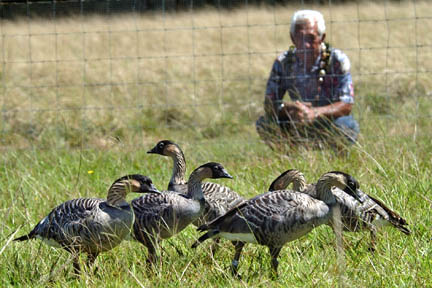— ADVERTISEMENT —


|
Recovery plan works to
boost nene ranks
Establishing a stable population would
take at least 30 years
Mongooses, cats and rats still threaten the endangered state bird, but federal wildlife officials announced yesterday a comprehensive recovery plan aimed at taking the nene off endangered and threatened species lists.
Establishing a stable Hawaiian goose population with no need for federal protection, however, would take a minimum of 30 years under U.S. Fish and Wildlife Service rules.
From just 30 birds in 1952, the number of nene has grown to an estimated 1,300 today, nearly all on Kauai, Hawaii, Maui and Molokai. The nene is found only in Hawaii.
A draft of the plan developed by the Nene Recovery Action Group, made up of experts from several state and federal agencies, is now open for public review and comment.
The first step will be to increase nene populations and distribution to change the bird from "endangered" to "threatened" status. That will take at least 15 years. To remove it from the federal protection programs altogether would take a steadily increasing population over an additional 15 years.
"Many caring, dedicated people have contributed a significant part of their lives to the protection and conservation of Hawaii's most beloved bird," said Gina Shultz, acting field supervisor for the wildlife service's Pacific islands office.
The recovery plan includes measures to spread out the nene population by releasing birds in more areas where they can thrive, in addition to steps that reduce threats to their survival, such as controlling predators.
About half the state birds are found on Kauai. Wildlife officials believe this is because mongooses, one of the bird's worst enemies, are not known to be established on the island.
Although nene grow up to 27 inches tall and weigh 5.5 pounds, their young often fall prey to much smaller predators. The birds have among the longest nesting seasons of any wild geese. Eggs have been found in all months except May, June and July.
— ADVERTISEMENTS —
— ADVERTISEMENTS —